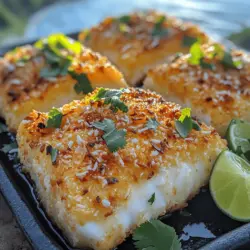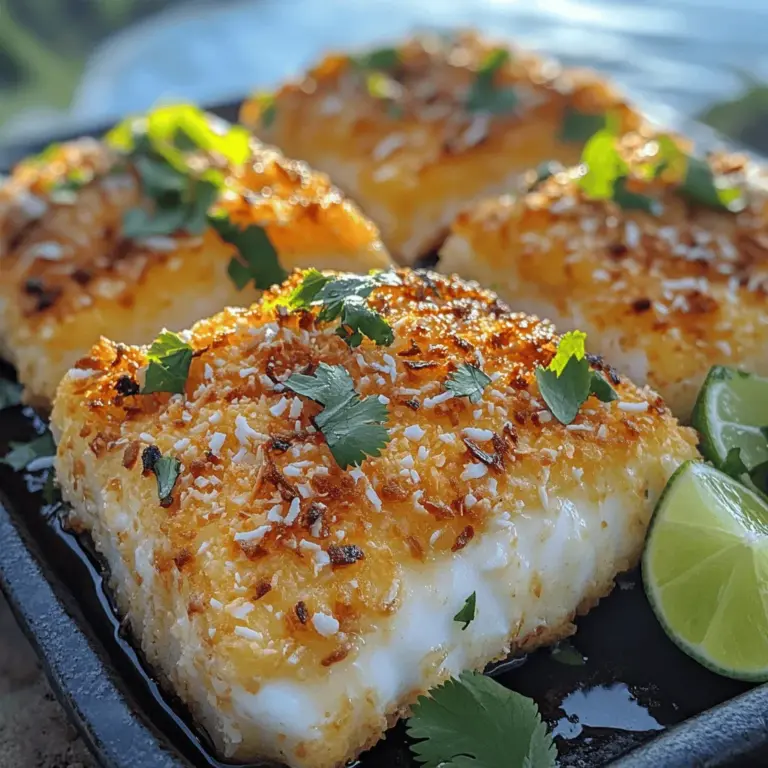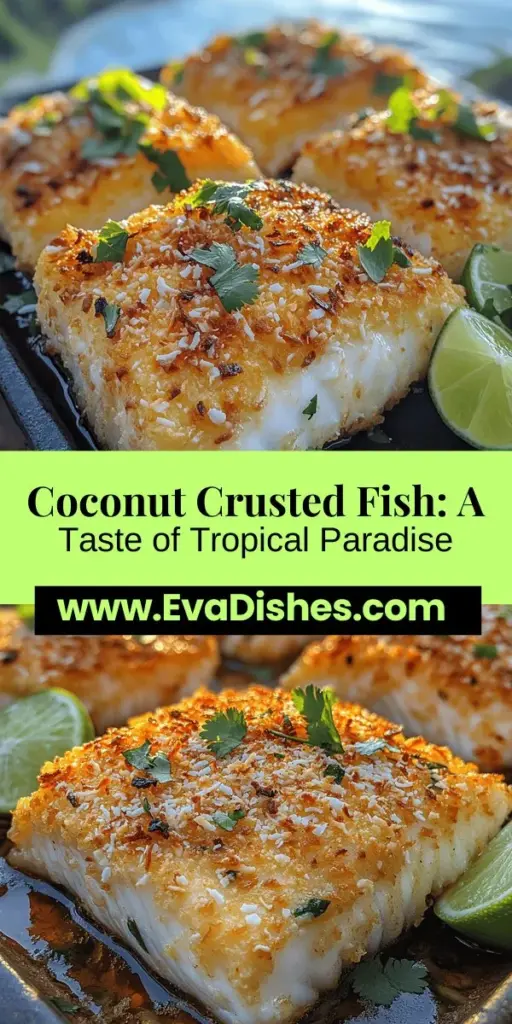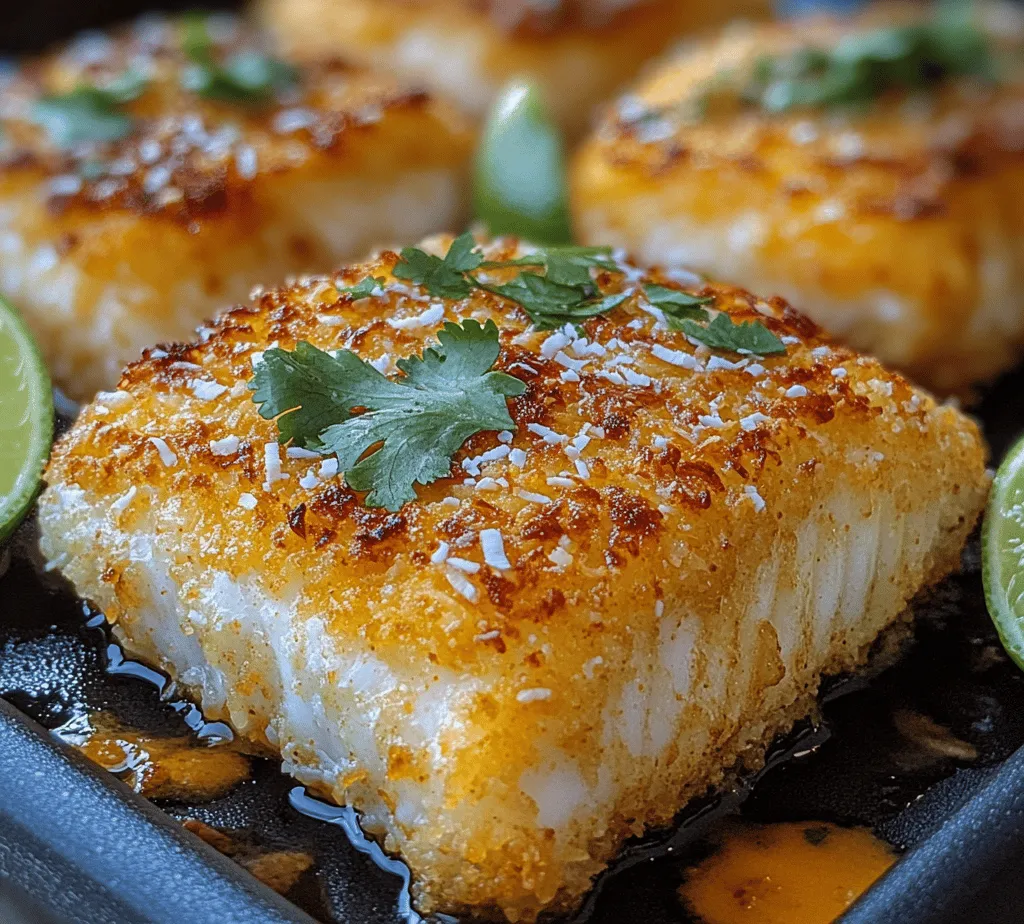Introduction
In the world of culinary delights, few dishes capture the essence of the tropics quite like Tropical Paradise Coconut Crusted Fish Fillets. This recipe combines the delicate flavors of fresh fish with the rich, sweet crunch of coconut, resulting in a meal that transports your taste buds straight to a sandy beach under the sun. The light, flaky texture of the fish pairs beautifully with the crispy coconut crust, creating a contrast that is both delightful and satisfying. Not only is this dish visually stunning, adorned with a golden-brown exterior, but it is also easy to prepare, making it a perfect choice for weeknight dinners or special gatherings alike.
The allure of coconut-crusted fish lies not just in its flavor but also in its versatility. It can be served as a main course with a side of tropical salsa, or as an appetizer at your next gathering. This dish invites creativity, allowing you to pair it with various sides and sauces to complement its unique taste. In this article, we will delve into the detailed steps of creating this delightful dish, explore its ingredients, and provide insights into its nutritional benefits and cultural significance.
Understanding the Key Ingredients
To successfully create Tropical Paradise Coconut Crusted Fish Fillets, it is essential to understand the key ingredients that make this dish shine. Each component plays a vital role in achieving the perfect flavor and texture.
Overview of Fish Selection
When it comes to selecting the fish for this recipe, freshness is paramount. The ideal choices for coconut-crusted fish fillets include:
– Tilapia: Known for its mild flavor and firm texture, tilapia is an excellent option for this dish. It absorbs flavors well and cooks quickly, making it a favorite among home cooks.
– Snapper: This fish boasts a slightly sweeter taste and a more robust texture. Snapper enhances the dish’s tropical essence, providing a delightful contrast to the coconut crust.
– Other Options: Cod, haddock, or any firm white fish can also work well in this recipe. The key is to choose a fish that is fresh and has a mild taste that won’t overpower the coconut.
Nutritional Benefits of Choosing Fresh Fish
Incorporating fresh fish into your diet comes with numerous health benefits. Fish is an excellent source of high-quality protein, omega-3 fatty acids, vitamins, and minerals. Omega-3 fatty acids, in particular, are known for their heart-healthy properties and anti-inflammatory effects. Regular consumption of fish can contribute to improved brain health, reduced risk of chronic diseases, and overall well-being.
The Role of Coconut
Coconut is the star ingredient in this recipe, offering a distinctive flavor and texture that elevates the dish.
– Shredded Coconut: Sweetened vs. Unsweetened: When selecting shredded coconut for this recipe, you may come across both sweetened and unsweetened varieties. For a more savory crust, unsweetened shredded coconut is preferred as it allows the natural flavors of the fish to shine. However, sweetened coconut can add a delightful contrast if you’re looking for a unique twist.
Health Benefits of Coconut in Cooking
Coconut is not only delicious but also packed with health benefits. It contains medium-chain triglycerides (MCTs), which are known to boost metabolism and promote weight management. Additionally, coconut is rich in dietary fiber, which aids in digestion and helps maintain a healthy gut. The antioxidants found in coconut can also support immune function, making it a nutritious addition to your meals.
Panko Breadcrumbs: The Secret to Crispiness
A crucial component of achieving the perfect texture in coconut-crusted fish is the use of panko breadcrumbs.
– Why Panko is Preferred Over Regular Breadcrumbs: Panko breadcrumbs are lighter, airier, and coarser than traditional breadcrumbs. This unique texture allows for a crispier coating that doesn’t become soggy during cooking, enhancing the overall eating experience.
– Gluten-Free Alternatives for Panko: If you’re following a gluten-free diet, there are several alternatives to panko breadcrumbs available, such as gluten-free breadcrumbs or crushed nuts. These options can provide a similar crunch while accommodating dietary restrictions.
Flavor Enhancers: Seasoning the Dish
To elevate the flavor profile of your Tropical Paradise Coconut Crusted Fish Fillets, it’s essential to incorporate seasoning.
– The Importance of Garlic Powder and Paprika: Garlic powder adds a savory depth to the dish while paprika contributes a mild smokiness and vibrant color. These flavor enhancers work together to complement the sweetness of the coconut and the freshness of the fish.
– Balancing Salt and Pepper for Optimal Flavor: A balanced seasoning of salt and pepper is crucial for bringing out the natural flavors of the fish and coconut. Be mindful not to over-season, as the goal is to enhance rather than mask the ingredients.
Preparation Steps for Coconut Crusted Fish Fillets
With a clear understanding of the key ingredients, it’s time to dive into the preparation steps for creating Tropical Paradise Coconut Crusted Fish Fillets. Proper preparation is vital for achieving a dish that is not only delicious but also visually appealing.
Preparing the Fish Fillets
Before you get started with the breading process, it’s important to properly prepare the fish fillets.
– Importance of Rinsing and Drying: Begin by rinsing the fish fillets under cold water to remove any residual fishy odor and impurities. After rinsing, pat the fillets dry with paper towels. This step is crucial as it helps the coating adhere better during the breading process.
– How Lime Juice Enhances Flavor and Freshness: To further enhance the flavor of the fish, squeeze fresh lime juice over the fillets. The acidity of lime not only brightens the dish but also helps to tenderize the fish, making it even more flavorful.
Setting Up the Breading Station
Creating an efficient breading station is key to a smooth cooking process.
– Step-by-Step Guide to Creating an Efficient Breading Layout: Start by gathering all your ingredients and equipment. You will need three shallow dishes: one for flour, one for beaten eggs, and one for the panko-coconut mixture. This setup allows for a streamlined dredging process, minimizing mess and ensuring consistent coverage.
– Tips for Maintaining Cleanliness and Organization: Keep your workspace organized by designating an area for each step of the process. Use separate utensils for each dish to prevent cross-contamination. Additionally, consider laying down parchment paper to catch any spills and simplify cleanup.
The Breading Process: A Step-by-Step Guide
Once your fish is prepared and your breading station is set up, it’s time to begin the breading process.
1. Dredging in Flour: Start by lightly coating each fish fillet in flour. Shake off any excess flour to ensure an even coating. This step helps the egg adhere to the fish, creating a better base for the coconut crust.
2. Dipping in Egg: Next, dip the floured fillet into the beaten eggs. Make sure the fish is fully coated but not dripping with excess egg. This moist layer is what will help the coconut and panko adhere properly.
3. Coating with Coconut and Panko Mixture: Finally, press the fillet into the panko-coconut mixture, ensuring that the fish is thoroughly coated on both sides. Use your hands to gently press the mixture onto the fish, creating a thick and even crust.
4. Repeat for Remaining Fillets: Continue this process for the remaining fish fillets, placing them on a clean plate once coated.
By following these steps carefully, you set the foundation for achieving a perfectly crispy and flavorful Tropical Paradise Coconut Crusted Fish Fillets.
Cooking the Fish: Techniques for Perfect Results
Now that your fish fillets are breaded to perfection, it’s time to cook them using techniques that will ensure optimal flavor and texture.
Heating the Oil: Getting it Just Right
The frying method used for cooking the fish is what brings out the best in this recipe.
– Importance of Oil Temperature for Frying: The key to achieving a crispy crust without overcooking the fish lies in the temperature of the oil. Heat a generous amount of oil in a large skillet over medium to medium-high heat. To test if the oil is ready, carefully drop a small piece of the panko mixture into the oil; if it sizzles immediately, you’re good to go.
– Signs That the Oil is Ready for Frying: When the oil is properly heated, you should see small ripples forming on the surface, and a few bubbles may begin to form. Avoid overcrowding the pan, as this can lower the oil temperature and result in sogginess.
With your fish fillets prepared and the oil heated to perfection, you’re well on your way to creating a stunning and delicious Tropical Paradise Coconut Crusted Fish Fillets that will delight your family and friends. Keep an eye out for the next part of this article, where we will delve deeper into the cooking process and additional serving suggestions for this tropical delight.
Frying Techniques for Crispy Fish
To achieve the perfect Tropical Paradise Coconut Crusted Fish Fillets, frying techniques play a crucial role. The goal is to create a crispy, golden crust while ensuring that the fish remains tender and juicy within. Here are some essential frying techniques to keep in mind:
1. Use the Right Oil Temperature: Before adding the fish fillets to the skillet, it’s important to preheat your oil. The ideal frying temperature is between 350°F to 375°F. If the oil is too cool, the fillets will absorb excess oil and become greasy. Conversely, if the oil is too hot, the crust may burn before the fish is cooked through. A good test is to drop a small piece of the coconut mixture into the oil; it should sizzle upon contact.
2. Frying in Batches: To ensure even cooking and crispy results, it’s better to fry in small batches rather than overcrowding the skillet. Overcrowding lowers the oil temperature, resulting in soggy rather than crispy fish. Depending on the size of your skillet, aim to fry 2 to 3 fillets at a time, allowing enough space for each piece to cook evenly.
3. Golden-Brown Perfection: Cooking time will vary depending on the thickness of your fillets. Generally, fish fillets should fry for about 3 to 5 minutes per side. To achieve that coveted golden-brown color, gently press down on the fillet with a spatula for even browning. Keep an eye on the fillets; when they are golden brown and easily flake with a fork, they are ready to be removed from the oil.
Draining and Finishing Touches
Once your fish fillets are perfectly fried, the next step is crucial for both health and flavor. Proper draining is essential to remove excess oil, ensuring a healthier dish.
1. Draining Excess Oil: Using a slotted spatula, carefully remove the fillets from the skillet and place them on a plate lined with paper towels. This will help absorb any excess oil and maintain the crispiness of the crust. Allow them to drain for a few minutes before serving.
2. Garnishing with Cilantro: For a fresh touch, sprinkle chopped cilantro over the fillets before serving. Cilantro not only adds a pop of color but also enhances the tropical flavor profile of the dish. You can also squeeze fresh lime juice over the fish to elevate the flavor, adding acidity that cuts through the richness of the coconut.
Pairing Suggestions for a Complete Meal
To create a well-rounded dining experience, consider the following pairing suggestions that complement the Tropical Paradise Coconut Crusted Fish Fillets:
Recommended Sides to Accompany Coconut Crusted Fish
1. Mango Salsa: One of the best accompaniments for coconut crusted fish is a refreshing mango salsa. The sweetness of the mango contrasts beautifully with the savory fish, while the acidity from lime juice brightens the dish. To prepare the salsa, combine diced mango, red onion, jalapeño, cilantro, and lime juice. This vibrant salsa not only enhances the flavor of the fish but also adds a burst of color to your plate.
2. Simple Green Salads: A light green salad can balance the richness of the coconut. Consider a mixed green salad with arugula, cherry tomatoes, cucumber, and a simple vinaigrette. The crispness of the greens will provide a refreshing counterpoint to the fried fish. Adding slices of avocado can also introduce healthy fats and creaminess to the dish.
Beverage Pairings: Enhancing the Tropical Vibe
To fully immerse yourself in the tropical experience, consider these beverage pairings that complement the flavors of the dish:
1. Cocktails: A classic mojito or piña colada can enhance the tropical vibe of your meal. The minty freshness of the mojito or the creamy sweetness of the piña colada pairs well with the coconut flavors in the fish.
2. Non-Alcoholic Options: For a non-alcoholic alternative, try a refreshing coconut water spritzer with lime or a tropical fruit punch made from pineapple, orange, and passion fruit juices. These drinks will not only refresh your palate but also complement the vibrant flavors of your meal.
Nutritional Benefits of Coconut Crusted Fish Fillets
Exploring the health aspects of the Tropical Paradise Coconut Crusted Fish Fillets reveals numerous nutritional benefits, making this dish a wholesome option for any meal.
Nutritional Breakdown of Key Ingredients
1. Protein Content from Fish: The primary ingredient, fish, is an excellent source of high-quality protein, which is essential for muscle repair and growth. Fish such as tilapia, cod, or snapper, commonly used in this recipe, are also low in fat and high in omega-3 fatty acids, which promote heart health.
2. Health Benefits of Coconut: Coconut, in the form of shredded coconut or coconut oil, provides dietary fiber, vitamins, and minerals. The medium-chain triglycerides (MCTs) found in coconut oil can improve metabolism and support weight management. Additionally, coconut is rich in lauric acid, known for its antimicrobial properties.
The Role of Healthy Fats in Cooking
Coconut oil serves as a healthy cooking fat, making it a popular choice for frying. Unlike other oils, it remains stable at high temperatures, reducing the risk of harmful compounds forming during cooking. Including healthy fats in your diet, like those found in coconut oil, can support brain health, improve nutrient absorption, and provide sustained energy.
Cultural Significance of Coconut in Cuisine
Coconut has a rich history and cultural significance in various cuisines, particularly in tropical regions.
The Use of Coconut in Various Cuisines
Coconut is a staple ingredient in many dishes across Southeast Asia, the Caribbean, and Pacific Islands. From coconut curries in Thai cuisine to rich coconut milk desserts in the Caribbean, this versatile ingredient enhances flavors and textures in diverse culinary traditions.
The Rise of Coconut-Based Dishes in Modern Cooking
In recent years, the popularity of coconut-based dishes has surged, especially with the rise of healthy eating trends. Coconut products are now widely available in supermarkets, making it easier for home cooks to incorporate them into their meals. This trend aligns with the growing interest in natural, whole foods and plant-based eating.
Conclusion
In summary, Tropical Paradise Coconut Crusted Fish Fillets offer a delightful blend of flavors and textures that can elevate any meal. This dish not only showcases the versatility of fish and coconut but also emphasizes the importance of using fresh, wholesome ingredients in our diets. By following the detailed preparation and cooking steps outlined in this article, you can bring a taste of the tropics to your dining table, creating a memorable experience for yourself and your loved ones. Enjoy the journey of cooking, and savor every bite of this incredible dish!



